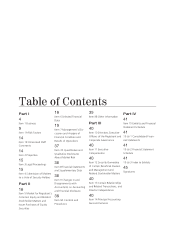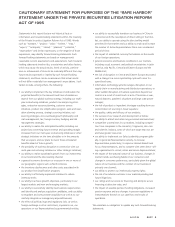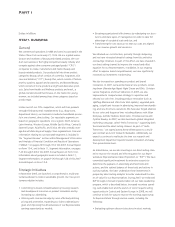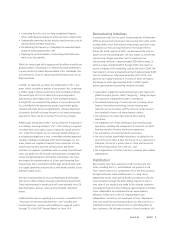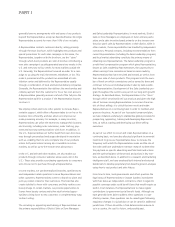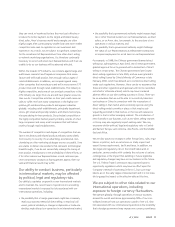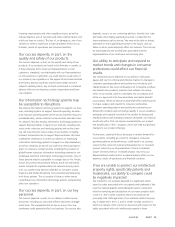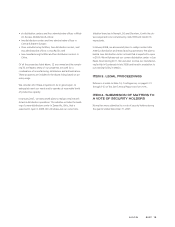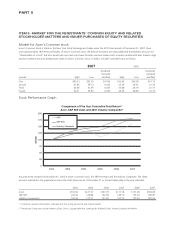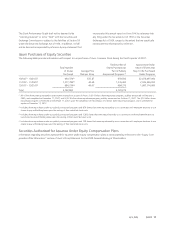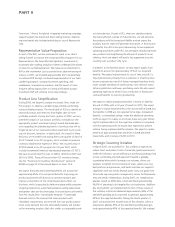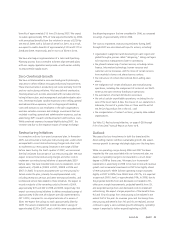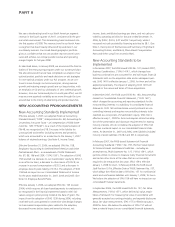Avon 2007 Annual Report Download - page 18
Download and view the complete annual report
Please find page 18 of the 2007 Avon annual report below. You can navigate through the pages in the report by either clicking on the pages listed below, or by using the keyword search tool below to find specific information within the annual report.PART I
restrictions. Another risk associated with our international oper-
ations is that the functional currency for most of our interna-
tional operations is the applicable local currency. Although we
implement foreign currency hedging and risk management
strategies to reduce our exposure to fluctuations in earnings and
cash flows associated with changes in foreign exchange rates,
there can be no assurance that foreign currency fluctuations will
not have a material adverse effect on our business, results of
operations and financial condition.
A general economic downturn, a recession
in one or more of our geographic regions
or sudden disruption in business conditions
may affect consumer purchases of
discretionary items, including beauty and
related products, which could adversely
affect our business.
Consumer spending is generally affected by a number of factors,
including general economic conditions, inflation, interest rates,
energy costs, gasoline prices and consumer confidence generally,
all of which are beyond our control. Consumer purchases of
discretionary items tend to decline during recessionary periods,
when disposable income is lower, and may impact sales of our
products. In addition, sudden disruptions in business conditions
as a result of a terrorist attack similar to the events of Sep-
tember 11, 2001, including further attacks, retaliation and the
threat of further attacks or retaliation, war, adverse weather
conditions and climate changes or other natural disasters, such
as Hurricane Katrina, pandemic situations or large scale power
outages can have a short or, sometimes, long-term impact on
consumer spending. A downturn in the economies in which we
sell our products, including any recession in one or more of our
geographic regions such as North America or a sudden dis-
ruption of business conditions in those economies, could
adversely affect our business.
Any future acquisitions may expose us to
additional risks.
We continuously review acquisition prospects that would comple-
ment our current product offerings, increase the size and geo-
graphic scope of our operations or otherwise offer growth and
operating efficiency opportunities. The financing for any of these
acquisitions could dilute the interests of our stockholders, result
in an increase in our indebtedness or both. Acquisitions may
entail numerous risks, including:
• difficulties in assimilating acquired operations or products,
including the loss of key employees from acquired businesses
and disruption to our direct selling channel;
• diversion of management’s attention from our core business;
• adverse effects on existing business relationships with suppli-
ers and customers; and
• risks of entering markets in which we have limited or no prior
experience.
Our failure to successfully complete the integration of any
acquired business could have a material adverse effect on our
business, financial condition and operating results. In addition,
there can be no assurance that we will be able to identify suit-
able acquisition candidates or consummate acquisitions on
favorable terms.
Third-party suppliers provide, among other
things, the raw materials used to
manufacture our CFT products, and the
loss of these suppliers or a disruption or
interruption in the supply chain may
adversely affect our business.
We manufacture and package almost all of our CFT products.
Raw materials, consisting chiefly of essential oils, chemicals,
containers and packaging components, are purchased from vari-
ous third-party suppliers for our CFT products. Almost all of our
non-CFT products are purchased from various suppliers.
Additionally, we produce the brochures that are used by Repre-
sentatives to sell Avon products. The loss of multiple suppliers or
a significant disruption or interruption in the supply chain could
have a material adverse effect on the manufacturing and pack-
aging of our CFT products, the purchasing of our non-CFT prod-
ucts or the production of our brochures. This risk may be
exacerbated by SSI, which will shift our purchasing strategy
toward a globally- coordinated effort. Furthermore, increases in
the costs of raw materials may adversely affect our profit mar-
gins if we are unable to pass along any higher costs in the form
of price increases or otherwise achieve cost efficiencies in manu-
facturing and distribution.
The loss of or a disruption in our
manufacturing and distribution operations
could adversely affect our business.
Our principal properties consist of worldwide manufacturing
facilities for the production of CFT products, distribution centers
where offices are located and where finished merchandise is
packed and shipped to Representatives in fulfillment of their
orders, and one principal research and development facility.
Therefore, as a company engaged in manufacturing, distribution
and research and development on a global scale, we are subject
to the risks inherent in such activities, including industrial acci-
dents, environmental events, strikes and other labor disputes,
disruptions in logistics or information systems, loss or impairment
of key manufacturing sites, product quality control, safety,


